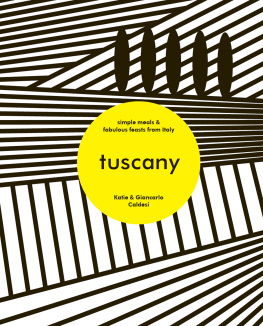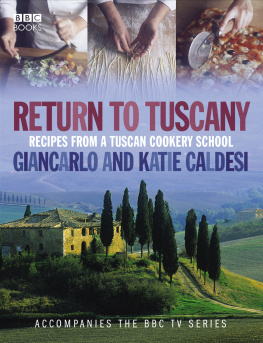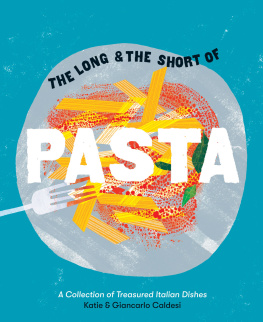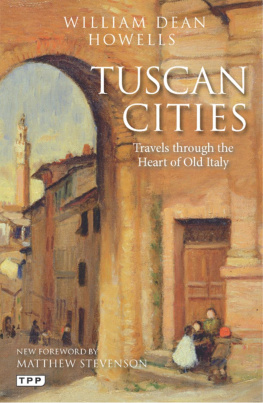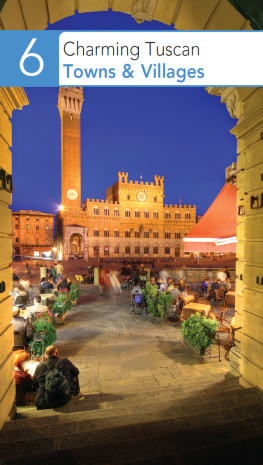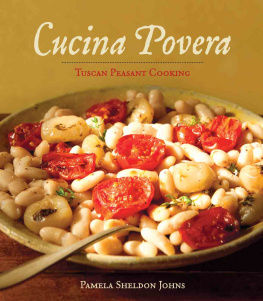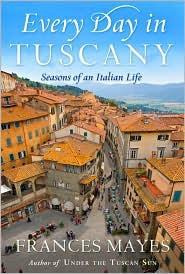recipe notes
Unless otherwise stated: all fruit and vegetables are medium-sized; all fruit and herbs are fresh; all eggs are free-range and medium-sized.
All olive oil used in this book is extra-virgin olive oil.
Raw or lightly cooked eggs should be avoided by pregnant women, the elderly and very young children.
Recipes that contain nuts should be avoided by those with a known allergic reaction to nuts and nut derivatives.
Oven temperature: these are given for fan ovens. If you are using a conventional oven, increase the heat by around 20C (50F). You can also check with the manufacturers handbook.
contents
-
-
-
Tuscany is a region of the soul... it is impossible to reduce it to a geographical place. Tuscany is rather felt, found, recognised, lived & inevitably loved.
-
Andrea Bocelli
(Italian singer/songwriter)
The Italians have the phrase ben curato, meaning well cared for; Tuscany is ben curato. On my first visit to this green and pleasant, fertile land I was mesmerised by the neat fields every hill and valley had some edible crop growing on it. It looked as though a giant hand, perhaps belonging to an old Etruscan god, had reached down and combed each field neatly into place. The thoughtful being had placed a perfectly sized town on top of each hill and drawn a little winding road with his finger up to each one. It is this order, the friendly and welcoming landscape that Tuscany possesses, that has attracted so many of us, over millennia, to visit and fall in love with this region. It is about the size of Wales, inhabited by just under 3.8 million people, yet more than 40 million tourists visit every year.
We have travelled all over Tuscany for the last 20 years, as it is Giancarlos homeland. He was born and raised in Montepulciano Stazione, a tiny village near the Umbrian border. He remembers a happy yet tough childhood living on his family smallholding, helping his mother with the cooking and his father on the land. They had little money and mostly ate what they grew. Marietta was Giancarlos mother; sadly she was very ill when I met her. I would have relished learning from her first-hand and often imagine I hear her whispering advice in my ear. I am fascinated by the way she, and her mother before her, used to cook. Both cooked over an open fire using a grill positioned over the embers and had a tripod for a cauldron (which we still have) for one-pot dishes. Baking happened once a fortnight in the outdoor oven.
Pre-1950s, life in Italy hadnt changed for generations, and I believe old Tuscan cooking (with some exceptions) was healthier than it is now. Everything the Caldesi family ate was organic, seasonal and fresh. And that was the norm. I want to adopt all Mariettas ideas of fresh home cooking the lovely herb-filled Tuscan dishes, the slow-cooked meat stews, the hearty soups and the light, just-picked salads but I want to translate them for todays cooks. When Giancarlo talked about how his mother ran her kitchen, we thought this might not be possible today, but in fact it seems increasingly relevant as we become more conscious of what we eat and what we waste. Mariettas food is what we should be eating now: good food cooked from scratch, from field to fork.
Post 1950s, motorcars, fridges and pesticides came in, sugar and dried pasta became widely available, flour was imported and women went to work. Believe me, although I love cooking, I dont want to be tied to a kitchen sink or a hot oven seven days a week, as Marietta was, and today many of our younger Italian friends of both sexes follow a career path outside the home. However, what many Tuscans still want is good home cooking. According to a study by Unioncamere, Italys chamber of commerce, the financial crisis and soaring unemployment have forced Italians to spend less and shop more cautiously, replacing fizzy drinks and sugary snacks with homemade produce. Half of Italians now buy only the essentials, according to the survey, and what they do buy is carefully chosen, with many buying directly from small producers and markets.
Living the Tuscan dream going back to the land
Around 15 per cent of Italians grow their own food and 17 per cent of these started in the last five years, coinciding with the financial downturn. Combined with the economic benefits of growing your own, Italians are increasingly worried about the quality and purity of food. The phrase cibo genuino crops up again and again, and Tuscans tell me that they want natural food that is uncontaminated with chemicals. The organic aisle in the Tuscan supermarket stretches far further than in my local supermarket in the UK. Biodynamic and organic wines are readily available, too.
There is something elemental about planting a seed, watching the plants develop and tasting the ripe fruit. It seems to me that Tuscans have never been as disconnected with the production of food as we have become. From medieval times to the present, Tuscan cuisine, just like the Etruscan cuisine before it (see ), is tied to the agriculture of the area. The real wine movement in the UK and the farm to table trend in the US seem quite new to us but the Tuscans have been growing, buying and cooking food in this way for generations. Our friend Fabrizio Biagi thinks we should all be moving towards the future with the methods of the past. He gave us an example: his friend catches fresh anchovies at night by lamplight in Viareggio. He gives them to Fabrizio who preserves them in jars under salt, and he in turn gives some jars back to his friend. Fabrizio then uses them (we ate one on thickly buttered bread heaven) and each time he opens the jar he has a connection, a relationship with that food and its origin, and knows every ingredient in it.
Many Tuscan families still have an orto an area for growing food whether it is outside the back door or on an allotment. There is a small but burgeoning movement of people choosing to grow in an orto sinergico, meaning to grow in synergy with the natural rhythms of the world. Our friends Livia and Nello, now in their seventies, have always farmed like this. Far from being a little cuckoo, it is a holistic approach that harnesses the power of nature by farming in harmony with insects, using mixed planting between flowers and vegetables and sowing according to the phases of the moon, the ciclo lunare, to help plants thrive. Even our friends local town newspaper suggests when it is best to cut your hair or when to plant seeds according to the phases of the moon. In towns where Tuscans cant grow their own food, there are an increasing number of zero kilometre restaurants specialising in locally sourced produce.

